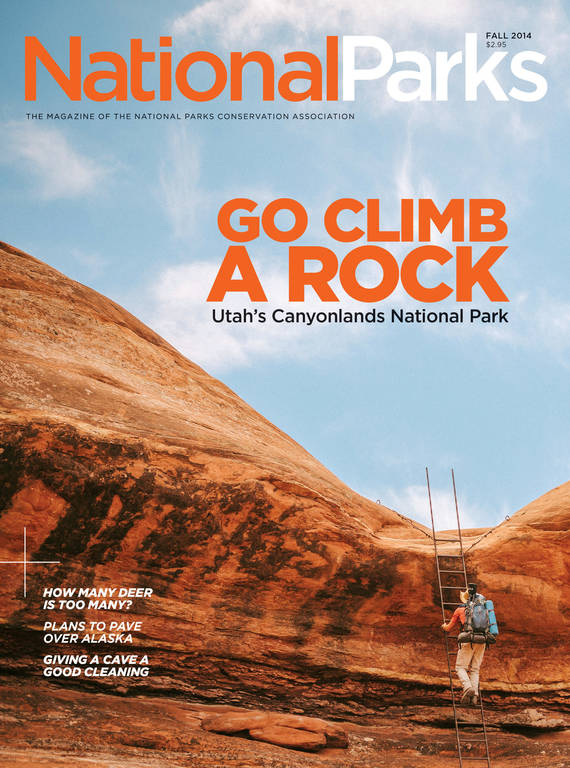Fall 2014
Tracking Down History
At Golden Spike National Historic Site in northern Utah, the National Park Service and a cast of dedicated volunteers revive the legacy of the first Transcontinental Railroad.
They run roughly parallel, sometimes crossing and sometimes retreating from each other, as each winds its curious path across the landscape. It’s quiet country out here: ranch and scrub, 30 miles to the nearest town. Hard to believe that this plateau once held the breathless attention of a nation and played host to some of its most influential men, or that events here changed the course of American history.
The berms are remnant grades of the first Transcontinental Railroad, which was blazed across the American West in the 1860s. Two corporations raced to build the road from its edges to the center: The Union Pacific (UP) hammered west from Omaha, and the Central Pacific (CP) blasted east from Sacramento. For seven arduous, hazardous, costly years, UP and CP crews labored toward each other across 1,800 miles of wilderness. The route—traversing three mountain ranges and a desert—is daunting even today, glimpsed through a car’s windshield from Interstate 80. This massive engineering project was built mostly by hand: Hands grasped the mauls that drove the spikes, steered the carts that hauled the fill, and drew the saws that cut the wooden ties. The endeavor demanded extraordinary persistence and claimed uncounted lives in falls, explosions, avalanches, and other hazards rarely encountered in settled parts of the country. The great gap between coasts zipped closed on May 10, 1869. The UP and CP lines met at Promontory Summit, a saddle on the crest of a range rising from the Great Salt Lake. The place of that meeting lies today within Golden Spike National Historic Site, which takes its name from the iconic ceremony heralding the railroad’s completion. On that day, politicians, boosters, and railroad executives presented four gold and silver spikes, along with a polished tie and a silver maul. Before a crowd of about 600, CP president Leland Stanford and UP vice president Thomas Durant gently tapped these spikes home.
12,000 STRONG
Reporters gathered at the tracks sent feverish dispatches home. The Salt Lake City Desert News exclaimed, “A thousand throbbing hearts impulsively beat to the motion of the trains as the front locomotive of each company led on majestically up to the very verge of the narrow break between the lines.” In what has been called the first live national media event, a telegraph wired to the silver maul and golden spike transmitted the final blows to a rapt national audience in real time, igniting celebrations from coast to coast. Chicagoans paraded in the streets, 220 cannons fired in San Francisco, and The New York Times reported “peals from the Trinity chimes and general rejoicing over the completion of the great enterprise.”
“This event was a key stepping stone in the progression of our history and sparked a huge take-off in what our nation was to become,” says David Kilton, an interpretive ranger at Golden Spike. In early 1869, San Francisco was the capital of an isolated, sparsely populated West. The journey from New York to San Francisco took months, cost upwards of a thousand dollars, and was fraught with risk. “Distance had a profundity that cannot be imagined now; a relative who had moved a hundred or a thousand miles away often seemed to have dropped over the horizon,” writes author Rebecca Solnit. People, goods, and information traveled only as fast as a ship could sail or a horse could gallop.
With the line complete, the cross-country journey cost $65 and took a week. The next day, the National Intelligencer in Washington, D.C., proclaimed, “We may expect in a week or two to be enjoying… the luscious fruits and vegetables of the golden fields of California in the markets of the Eastern cities.” Ideas and information—from stock market figures to fashion trends—could be transmitted instantaneously on the telegraph line built alongside the railroad. The New York Times exclaimed, “The inhabitants of the Atlantic and the dwellers of the Pacific slope are henceforth emphatically one people.” A national culture and economy took root, and the UP and CP were its first modern corporations.

National Parks
You can read this and other stories about history, nature, culture, art, conservation, travel, science and more in National Parks magazine. Your tax-deductible membership donation of $25 or more entitles…
See more ›Promontory Summit blazed to life in 1869, but the town didn’t persist on the arid plateau. In 1904, the transcontinental route relocated to Lucin Cutoff, a more direct route across northern Utah via a trestle through the Great Salt Lake. The rails were salvaged during World War II, following an un-spiking ceremony. The wooden ties—valuable in this timber-scarce terrain—were put to good use by the area’s ranchers; Kilton encourages visitors to take a close look at fences and outbuildings in the surrounding countryside, to see if they can spot any original ties.
Thanks to the National Park Service and a dedicated cast of volunteers, visitors to Golden Spike need not rely solely on their imaginations to conjure the scene from May 10, 1869. The final stretch of track has been faithfully rebuilt and hosts two steam-powered replica locomotives; volunteers now stage costumed reenactments of the legendary Golden Spike ceremony. “We get the crowd involved during the show, so they come away with a feeling that they’ve learned what took place here,” says volunteer John Ott. He likes to talk about the Transcontinental Railroad’s transformational role in American history and says visitors to Golden Spike tend to share his enthusiasm. “For them to drive all the way out here, you know they’ve got to be interested in this story,” jokes Ott. Every summer weekend, he plays host to those crowds, sweltering in a wool costume under the desert sun, helping to recreate the moment when the blows from one man’s hammer echoed across the nation, ringing in a new era in American history.
About the author
-
 Julia Busiek Author
Julia Busiek AuthorJulia Busiek is a writer living in Oakland. She's worked in national parks in Washington, Hawaii, Colorado and California.



